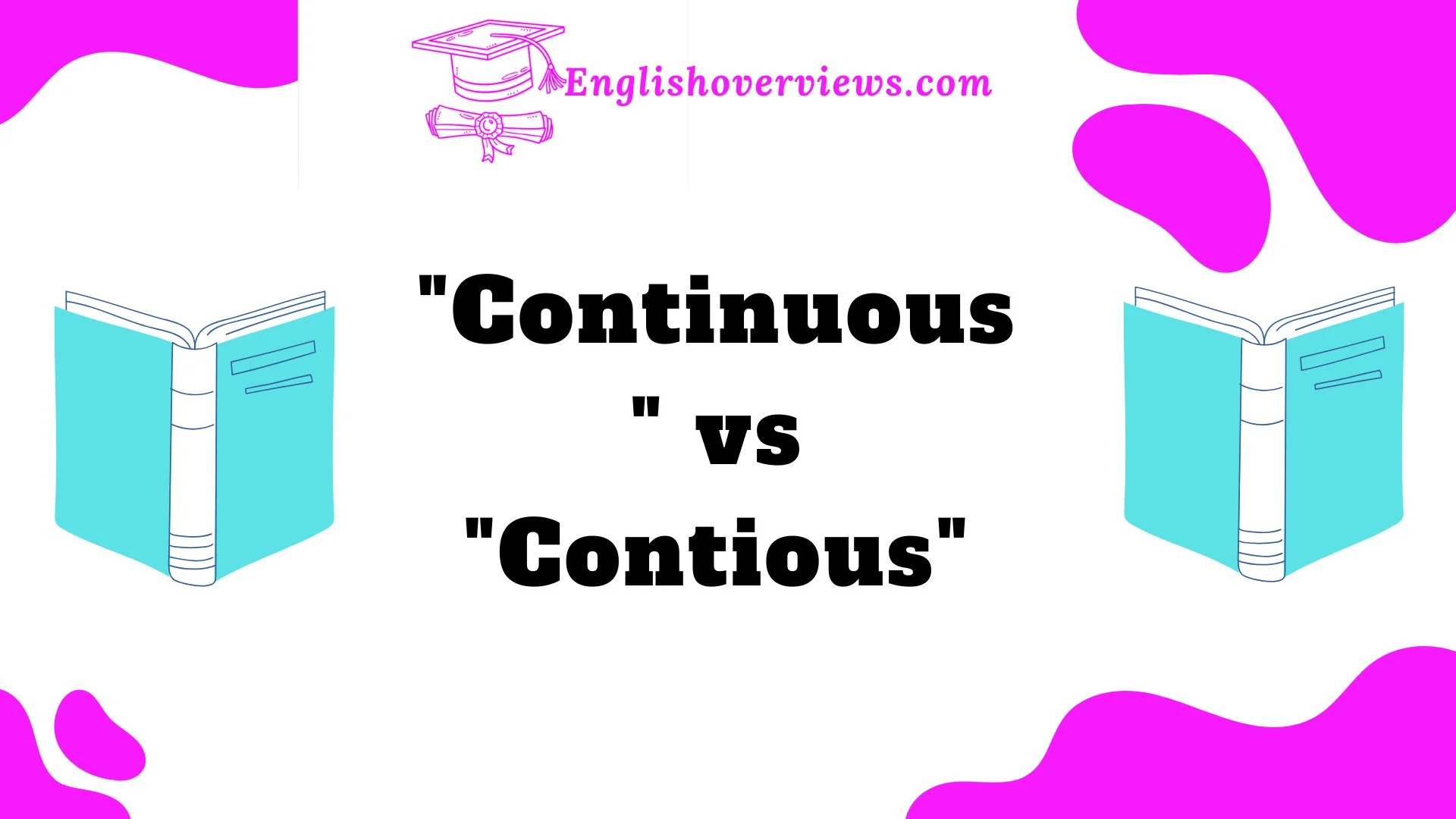If you’ve ever found yourself wondering whether “contious” is a real word, you’re not alone. It’s a common confusion, especially when we’re typing quickly or not paying full attention to our spelling. In this blog post, we’ll break down the difference between the terms “continuous” and “contious”, how to use them correctly, and why this distinction matters.
Whether you’re a student, professional, or just someone who wants to improve your writing, understanding these subtle differences will help you communicate more effectively and avoid common mistakes.
What Does “Continuous” Mean?
When you use the word “continuous”, you are referring to something that goes on without interruption. It implies an ongoing process or a sequence of actions that doesn’t stop. In various contexts, continuous can describe time, movement, or actions that happen seamlessly without breaks.
Here are a few examples of how continuous is used in sentences:
- Time-related: “The continuous ringing of the phone drove me aggravate, .”
- Action-related: “She gave a continuous effort throughout the project.”
- Movement-related: “The river flows in a continuous stream through the valley.”
In these examples, the key idea is that something is uninterrupted. For instance, the phone is ringing nonstop, the effort is sustained, and the river flows continuously. The word “continuous” is often used in technical, scientific, or everyday settings to describe things that don’t pause or stop.
What Is “Contious” and Why It’s Incorrect?
Now, let’s tackle the elephant in the room: “contious”. You might have seen this word pop up in writing, but here’s the truth: it’s not a real word in the English language. It’s a common misspelling of “continuous”, often due to the similarity in sound. The confusion typically arises when people type quickly or rely on spell check, which may not catch every error.
So, why do people write “contious”? Well, it’s likely due to how the two words sound. English speakers tend to pronounce the word “continuous” in a way that makes the “u” sound less distinct, leading some to mistakenly skip it in writing. However, no matter how it sounds, “contious” doesn’t belong in your vocabulary.
The correct word to use is always “continuous”.
Table: Correct Usage vs Incorrect Usage
| Correct Word | Incorrect Word |
| continuous | contious |
Remember, “contious” is simply a spelling error. Stick with continuous to avoid confusion and maintain credibility in your writing.
Correct Usage: Continuous vs. Contious
So, why is it essential to use “continuous” instead of “contious”? The simple answer is: accuracy matters. Misspellings can diminish the professionalism and clarity of your writing. Imagine reading a report or an email filled with spelling errors; it’s not only distracting, but it also makes you question the credibility of the writer. Correct spelling shows attention to detail and enhances the reader’s trust in your work.
Let’s explore the correct usage of continuous in more detail:
When to Use “Continuous”
- Time-based: When you want to describe something that lasts without interruption over time.
- Example: “She worked on the project continuously for five hours.”
- Action-based: When an activity or action continues without stopping.
- Example: “The movie had a continuous storyline from start to finish.”
- Process-based: For something that happens over and over, like a process or event.
- Example: “The continuous growth of the company was impressive.”
Never use “contious” in these situations. Using the incorrect spelling can confuse your readers and hinder your message.
The Importance of Proper Spelling in Communication
Imagine reading an email from your boss with a glaring spelling error. It wouldn’t inspire much confidence, would it? Similarly, using the correct spelling of “continuous” in your writing helps ensure your message is clear and your credibility remains intact.
Here’s why correct spelling is so important:
- Professionalism: Proper spelling is often associated with a high level of professionalism. It shows that you care about your work and that you’ve put in the effort.
- Clarity: Misspelled words can create confusion. If readers come across a term they don’t recognize, they might stop reading or misunderstand the message.
- Trustworthiness: When your writing is polished, your readers are more likely to trust you. Whether it’s a report, email, or social media post, correct spelling shows you value your audience.
Common Mistakes to Avoid
It’s not just “contious” that causes confusion. There are several other common spelling and usage mistakes related to the word “continuous”. Here are a few to watch out for:
- Continual vs Continuous:
While both terms refer to something happening over time, “continual” implies that something happens repeatedly with pauses in between, while “continuous” refers to something that happens without any interruption.- Example: “He took continual breaks during the meeting.”
- Example: “The continuous noise from the street kept me awake all night.”
- Contiguous:
“Contiguous” refers to things that are adjacent or next to each other, usually geographically.- Example: “The two countries share a contiguous border.”
- Continuity:
This is the noun form of continuous.- Example: “The continuity of the storyline was maintained throughout the novel.”
Real-World Examples and Applications
Let’s look at some real-world cases where using “continuous” correctly is important. Below are examples from different fields that demonstrate why this distinction matters.
Case Study 1: Business Communication
In business emails, reports, and presentations, clarity is key. If you’re discussing a project timeline, using “continuous” will accurately convey that the process or effort is ongoing without interruption.
For instance, an email to a client might read:
“Continuous updates will be provided throughout the project to ensure everything stays on track.”
Imagine replacing continuous with contious—it would throw off the entire professional tone of the message.
Case Study 2: Scientific Research
In scientific writing, accuracy is even more crucial. Researchers might use “continuous” to describe processes or measurements that occur without interruption, such as in environmental studies.
Example:
“The continuous monitoring of air quality is essential to assess long-term pollution levels.”
In this context, using “contious” would be a clear sign of sloppy writing and reduce the paper’s credibility.
Final Thoughts
To wrap things up, understanding the difference between “continuous” and “contious” is simple but essential. Always use “continuous” to describe something that happens without interruption. Avoid the misspelling “contious”—it’s not a word in the English language.
By being mindful of this small detail, you’ll improve your writing, ensure clear communication, and enhance your professional image. Proper spelling is a small but significant part of effective writing, so make it a habit to double-check your work before hitting send or publishing.
Looking for More Help?
If you’re looking to improve your writing or brush up on more grammar tips, check out these resources:
- Grammarly: An online tool to help you catch spelling errors and improve your writing.
- Merriam-Webster Dictionary: For quick reference on word meanings and spellings.
- Purdue OWL: A comprehensive resource for writing and grammar rules.
FAQs
Is “contious” a word?
No, “contious” is not a correct word in English. It’s a misspelling of “continuous.”
When should I use “continuous”?
Use “continuous” when you are describing something that happens without interruption, such as a process, event, or action.
Can “continuous” be used in any context?
Yes, “continuous” can be used in various contexts, including time, actions, and processes, as long as the thing being described happens uninterrupted.
This guide gives you all the tools you need to use “continuous” correctly. By following these tips, your writing will not only be more accurate but also more professional.

English Overviews is a resourceful website dedicated to providing valuable content related to grammar and vocabulary. Muhammad Haroon has made notable contributions, sharing insights on various subjects, including WordPress themes and plugins. The primary goal of the site is to help users improve their English language skills effectively.











